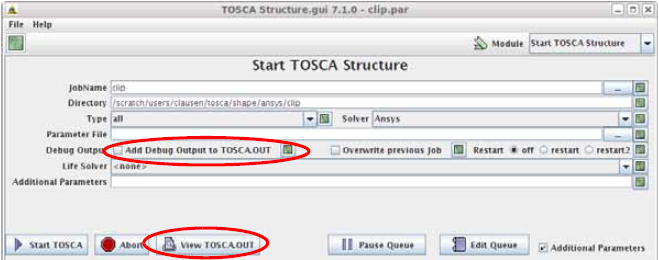Logging | ||
| ||
Logging is always done to the command shell and to the file <jobname>/TOSCA.OUT file. The following levels can be used.
| Level | Comment |
|---|---|
WARNING |
(Not recommended) Only WARNINGs and ERRORs are printed. |
NOTICE |
Default output to STDOUT. Only the most important logging. |
INFO |
Default output to logfile TOSCA.OUT. |
DEBUG |
Very verbose output, mostly for support. |
TRACE |
(Not recommended) Extremely verbose, major performance loss, only for developers. |
TOSCA.OUT
The logfile TOSCA.OUT is the main logfile of Tosca Structure. The logfile is at best viewed in a text editor that uses
a fixed width font (for example, Courier New). The structure of the logging lines
is:
(<log tag>)[<teime stamp>|<executable>]<message>
Where:
<log tag> |
=CRITICAL
|
<time stamp> |
Current time in format HH:MM:SS (Hours, Minutes, Seconds). |
<executable> |
Name of the executable that wrote the logging message. |
| Log-tags | Interpretation |
|---|---|
CRITICAL |
A critical error has occurred within the program. Contact support and explain. |
ERROR
|
An error has occurred during the execution of the optimization system and the user should be able to make changes in the optimization definition or finite element model to correct the problem. Take note of previous warnings. |
WARNING |
A warning indicates that a problem has been identified, but the optimization system continuous. |
NOTICE |
Very general, important information (for example,
Starting Tosca Structure
optimization module - design cycle 6
). |
INFO |
Information for the user. |
DEBUG |
Very verbose output, mostly for support. Debug messages are not printed to
TOSCA.OUT using default settings. To enable debug output in TOSCA.OUT, add
--loglevel debug to the command line. |
TRACE |
Extremely verbose output where a major performance loss is to be expected. Only for developers. |
Special Logfiles
In addition to TOSCA.OUT, a few other logfiles can be useful for troubleshooting special problems:
| Logfile | Comment |
|---|---|
authorization.log |
Logging from Tosca Structure’s authorization module tosca_server is written to this file. In case of licensing/authorization problems, see this file for details. |
signal.log |
This log file has content only if you interrupt the optimization process with
a SIGNAL, typically by pressing Ctrl +
C in the command prompt. Tosca Structure will then kill the running subprocess, optionally
using a script defined by the setting $killscripts. See CONFIG for
details. |
TOSCA_post.OUT |
This logfile is generated when using the command line flags -- smooth
or -- report. This enables the user to generate SMOOTH or
REPORT results during a running optimization. |
Viewing TOSCA.OUT Using Tosca Structure.gui
- To view TOSCA.OUT in Tosca Structure.gui, select Tosca Structure as Module.
- Select View TOSCA.OUT.
This procedure and also the request of logging on debug level are shown in the following figure:
 |
To add debugging output in TOSCA.OUT, activate the check-box Debug Output.
Changing Logging Using the Command Shell
To change loglevel in TOSCA.OUT, use the following command line parameter:
tosca --loglevel <new_level> ...
To increase the amount of output to the command shell, set the parameter:
tosca --loglevel_stdout <new_loglevel>
| Important:
Note that
|
The following example demonstrates how to increase loglevel to INFO on the command shell and DEBUG output into the logfile TOSCA.OUT:
tosca --loglevel_stdout INFO --loglevel DEBUG ...
Tips and Tricks Viewing TOSCA.OUT
| Topic | Tips and Tricks |
|---|---|
| Finding errors | Search for the word (ERROR and make sure that your editor has not activated
regular expressions. This search should always be done from the beginning
of the logfile because the first printed error message is usually of greatest
importance. |
| Runtime | You can view the runtime or elapsed time of each executable in a Tosca Structure run by searching for Elapsed:
The time format is in HH:MM:SS. In this case, we see that Abaqus has run 1
minute and 26 seconds, whereas the optimization module, tosca_opt, only
spent 4 seconds.
|
| How is my FE-solver called? | All calls of executables are written in the logfile TOSCA.OUT. To see how a
certain executable (for example, your FE-solver) is called, search the file for
Calling. In the search results you will also see the FE-solver
call; for example:
The number in the parenthesis Calling(<pid>) is the
process identification number, PID. |
| Debug output from only one executable | Using loglevel debug is very verbose and this might be annoying if only logging
from one single executable is of interest. There is a way of getting
debugging information only for certain executables:
|